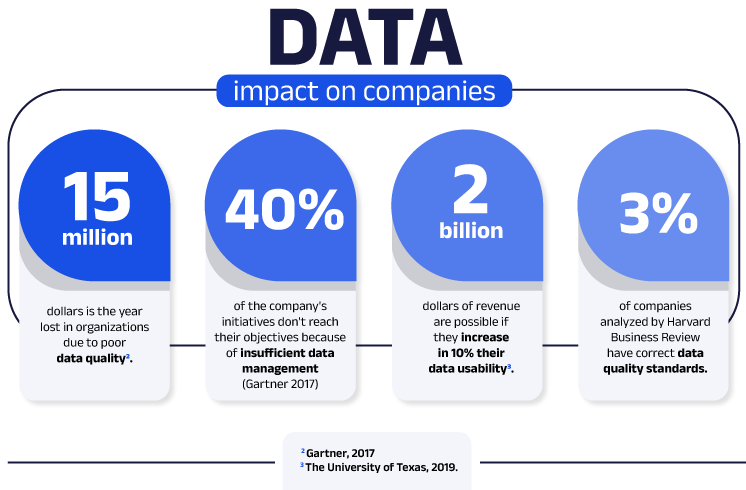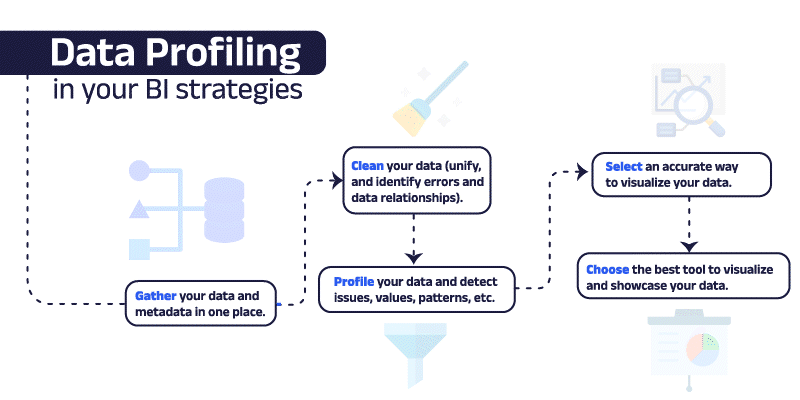What is Data Profiling and how does it impact Business Intelligence strategies?
Have you or your team ever lost control of your data due to its volume? In the digital transformation era organizations and specialized areas have had to adopt new practices in their processes and operations as data generation grows minute by minute.
This affects the teams that deal with data since the volume could reach a point where it becomes impossible for humans to manage and analyze. How could an analyst examine 1 million datasets in weeks or days? This work involves months and more resources.
Challenges like the one mentioned hinder Business Intelligence performance within organizations since this strategy could affect the future of the organization due to poorly informed decisions based on data.
For example, imagine the sales that a department store has per day, per week, per month, or per year. This information must be processed and analyzed for reports that will later become indicators to forecast future scenarios and thus make decisions later on.
However, this last step will rely on working with the correct data to later study it and thus generate reports in a timely manner, a situation that, as we mentioned before, is a challenge for agility and human capacity.
Regarding the gigantic universe of information, how do I know which data I have, how can I make sure it is accurate? The answer is Data Profiling, an extremely useful technique for a Business Intelligence strategy that involves data quality, another important step within it, which we then delve into its importance and impact on companies.
What is Data Profiling?
Data profiling is an analysis technique that allows for deepening the state of the data and its relationship with other areas or databases. It also identifies inconsistencies, inaccuracies, and errors to prevent them: it is mainly used to know the data’s condition.
In another one of our content, we share the impact of Data Profiling on information quality and the steps to start this process within your company.
Once we have defined the profiling approach, it is necessary to mention why a process like this is key to the smart development of an organization. Among the benefits of data profiling are the following:
- Quality: It helps to identify information inconsistencies and errors to make easier its subsequent cleaning in another procedure.
- Understanding: With data profiling, it is more accessible to know how the information and its values are distributed, its relationships between fields, and trends.
- Agile search: Makes easier the information located within a storage space regardless of its capacity.
- Cleaning: By helping you identify problems in data, cleaning becomes a less demanding process.
Take the following into consideration: Data Profiling helps you know what information you have within a storage system, while data quality refers to the solving of errors found in said information.
If your information volume is roughly 1 million, with this technique you can discover valuable insights based on its characteristics for a better understanding of your data.
In addition, the presence of a data profiling process unlocks many doors to improve information treatment in companies, with quality being one of the bases for future procedures such as decision-making and an effective path to Business Intelligence.
Why does Data Quality impact Business Intelligence?
Let's start by showing the role of Business Intelligence today. It is the accumulation of actions or strategies that transform data into insights for companies1, thus we could assume that data quality is an action that takes part directly that directly participates in the company development.
In this sense, both terms (Data Quality and Business Intelligence) are connected in a way that one process leads to the other; having quality data is crucial for making decisions and an intelligent business process cannot be complete without a strategy responsible for giving the data the quality it needs.
Consequently, it becomes so important to know the quality impact, so that you can identify the factors that make data quality essential in Business Intelligence. We describe them in the following points:
- Better decision-making: Areas such as sales, marketing, human resources, finance, and more, by having quality information, can execute their business decisions.
- Confidence and tranquility: Having accurate information reassures teams and stakeholders that their processes are on the right track, thus eliminating risks due to inaccurate results that cost time and resources.
- Product or service reputation: Good data management implies better engagement with your target audience, so by having a personalized offer your customers will be satisfied with getting what they want.
- Organizational collaboration: By working with reliable information, the culture of collaboration benefits in more than one aspect, it is no longer necessary to constantly check information and times and processes flow optimally.
Currently, data has become a very valuable asset for companies that consolidate it in their business strategy, based on the contributions they make to both quantitative and qualitative growth. Here is part of its effect:

As you can see, the quality of data plays such a role that it can determine the company's progress or its stagnation, and to reach an effective point of this practice, it must first be assisted by the step that we addressed at the beginning, data profiling.
How does profiling improve data quality?
According to what we mentioned in the initial paragraphs, it can be concluded that data quality is linked to Business Intelligence and vice versa. However, there is an equally important player in the game, which is Data Profiling, which will trigger the next processes. Without Data Profiling there is no Data Quality.
Both concepts are related since they have the common goal of obtaining quality within the information. Profiling identifies the content, format, origin, and structure under which your data is stored so that in later steps the required quality can be provided to the data thanks to the first insights acquired: once there is an understanding of what data there is, it is time to grant them the standards according to strategies and operations.
Data quality is an ongoing process that involves working on the accuracy, integrity, and significance of the information.
The techniques aforementioned are cogs that work to support each other. So now you know, if you want to optimize your information under quality standards as required by your company, you must consider both stages to execute smart decisions.
Types and techniques of data profiling
We have already addressed the definition, impact, and relationship of Data Profiling with quality. Now is the time to share the types and techniques of it.
This technique should be applied at the start or early stage of your quality process, or when running a warehouse project. That is why there are different paths that you and your team can take to ensure that it will provide the solution you want for your information.
Types of data profiling
- Structure discovery: Involves mathematical and statistical checks on data such as maximum, minimum, total, average, etc., and ensures structure and consistency.
- Content discovery: This type focuses on reviewing the recorded data to find possible errors or incomplete fields. Analyze rows and columns to check inconsistencies.
- Relationship discovery: This, as its name suggests, is responsible for verifying whether a database is linked to another or to a spreadsheet that contains related information.
Data Profiling techniques4
- Column profiling: Works to identify patterns in your data and analyzes metadata structure.
- Cross-column profiling: Scans columns and tables to find a relationship between them.
- Cross-table profiling: Establishes if there is any link between tables and if they directly depend on any other.
- Validation of data rules: Ensures that databases comply with standards such as formats, weight, storage location, etc.
An early diagnosis or discovery of the state of your information can be the spark that triggers more successful processes both inside and outside an organization, such is the case of pertinent data visualization.
Profiling, among other effects, allows you to determine the most appropriate display state for your data, for example, a bar chart for categorical data or a scatterplot for continuous data. Thus it is possible to achieve a clear presentation for a client, partner, or investor.
Are you ready to start and give your data enough quality to turn it into an asset? For this, you must consider this process within your Business Intelligence strategy.

Conclusion
Data profiling is an extremely useful process to boost a Business Intelligence strategy, in addition to providing a solution to human resources that invest effort in exploring data to provide a diagnosis, streamline the operation, and optimize results.
The three concepts covered in this blog act like a chain, Data Profiling drives quality, which in turn enables good Business Intelligence execution in an organization.
There are currently platforms on the market that help to obtain insights through processes such as profiling and data quality assurance. Arkon Data's objective is to provide a specialized solution to those companies that work with high volumes of data, where profiling becomes a necessity.

- Connect your data in one place and guarantee an efficient discovery process.
- Solve data quality issues with automated processes.
- Calculate statistics like the average, median, and standard deviation to understand patterns.
- Link with different BI software and applications to create reports after Data Profiling.
2 Gartner, 2017.
3 Universidad de Texas, 2019.
4 Balu Rama, 2022.




